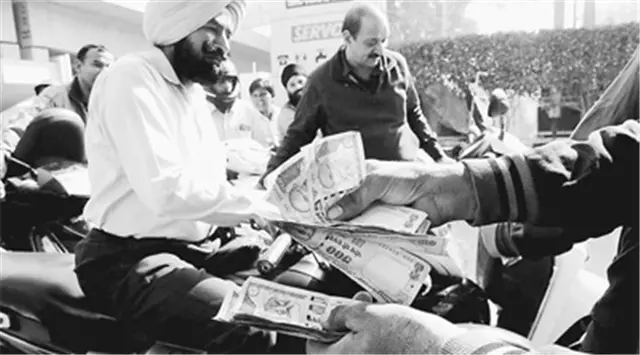Nepal's banking system has at least held banned Indian currency (IC) notes of 500 and 1000 rupees worth 35 million rupees (524,737 U.S. dollar), Nepal's central bank said on Thursday.
After banning these IC notes from in Nepal on Wednesday, a day after India's prohibition of them there, Nepal Rastra Bank (NRB) had sought availability of such notes with Nepal's banks, other financial institutions and money changers.
"As reported by the banking institutions licensed by us, they have held banned IC notes worth 35 million rupees as of late hour of Thursday," said Narayan Poudel, spokesperson of NRB, adding that the amount could cross 40 million Indian rupees (599,700 U.S. dollar) once remaining a few banking institutions send their details about the stock of such notes.
However, Nepalese central bank believes that the traders and general public living in bordering areas with India as well as Nepalese migrant workers who had returned from India might have held huge amount of these notes. "We don't have record of IC notes held by general public," said Poudel.
Some banks ran out of cash. At others police were called in to manage queues of anxious customers hoping to change their savings for legal tender.
But many low-income Indians, traders and ordinary savers who rely on the cash economy have been badly hit.
Banks were shut on Wednesday to allow them enough time to stock new notes following Tuesday night's announcement. There are also limits on cash withdrawals from ATMs.
The two notes accounted for about 85% of the cash in circulation.
"I went home for Diwali and my parents gave me money as a gift," Vijay Karan Sharma from Chhattisgarh, a student at Delhi University, told the BBC. He said he had been standing in line since morning.
"I wish they had a simpler system for students. I desperately need cash to pay my rent and buy books and food."
The IC notes denominated upto 100 rupee has long been freely exchangeable in Nepal. But, India had allowed Nepal to use IC notes of 500 and 1000 rupees last year only after Nepal made request to its southern neighbour for such provision considering easing Nepalese migrant to carry Indian currency notes while returning home. They were facing the risk of being robbed on the way while carrying large bundle of low denominated IC notes.
After India allowed Nepal to use of IC notes of 500 and 1000 rupees last year, the Himalayan nation had allowed Nepalese migrant workers and Indian nationals to carry such notes upto 25,000 rupees in Nepal.
Sudden Indian decision of banning the use of these notes left shockwaves across Nepal's banking sector as well as people around the bordering areas and migrant workers' families. Officials of NRB and Nepalese banks said that they were getting constant inquiries from people whether the IC notes held by them would be exchanged.Is there a limit on the amount an individual or household can cash in?
It seems not. An individual can put as much as he or she likes into the bank - but withdrawals are limited so the banking system may end up being flooded with cash.
Government guidelines say it is possible to exchange up to 4,000 rupees per day up to 24 November - anything over this will be subject to tax laws. People can also withdraw up to 10,000 rupees from a bank per day and a maximum of 20,000 rupees per week.
Are the new notes safer?
New 2,000 and 500 rupee denomination notes with new security features are being given to people to replace those removed from circulation.
A new 1,000 rupee note "with a new dimension and design" will also be introduced in due course, a senior government official said on Thursday.
How will overseas Indians exchange banknotes?
Overseas Indians can deposit the banknotes in their non-resident rupee denominated accounts.
What will foreign tourists carrying the banknotes do?
They can purchase foreign exchange equivalent to 5,000 rupees using these bank notes at airport exchange counters until midnight on Friday.
What's been the reaction in India?
Indian social media has been talking of little else.
The top trend on Twitter India has been #CashCleanUp with tweets ranging from the frustrated to the humorous, as many Indians came to terms with the fact that much of their day would be spent in queues.
(APD)
 简体中文
简体中文




